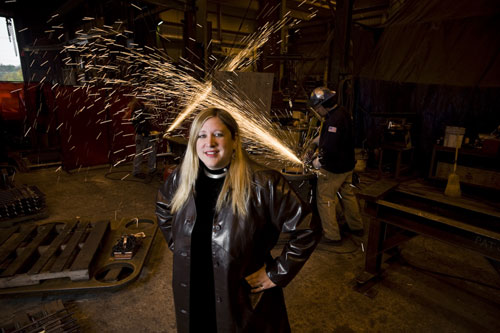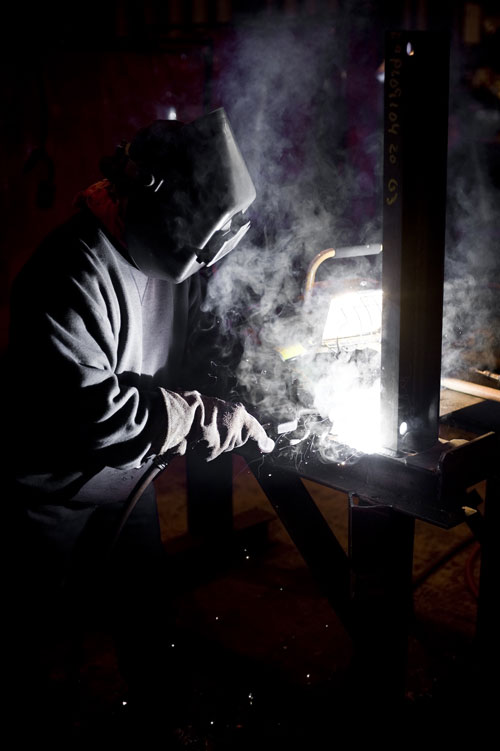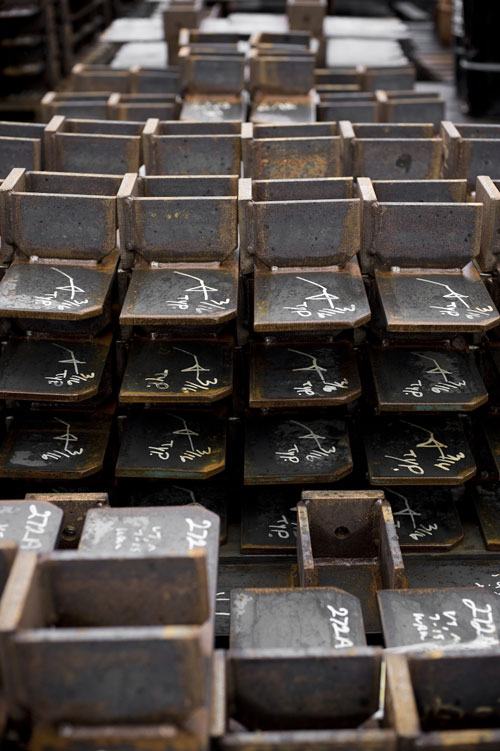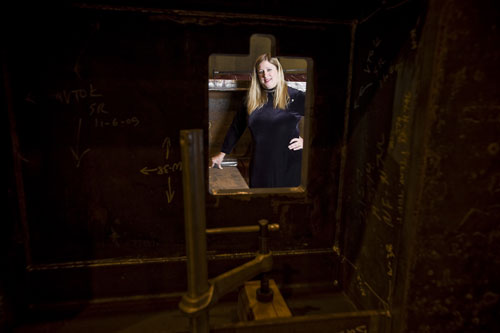 Chandra Brown started as a temp at Oregon Iron Works. Now she’s a hard-charging VP who’s snapping up big streetcar contracts and building a reputation as one of the state’s most influential players.
Chandra Brown started as a temp at Oregon Iron Works. Now she’s a hard-charging VP who’s snapping up big streetcar contracts and building a reputation as one of the state’s most influential players.
Chandra Brown started as a temp at Oregon Iron Works. Now she’s a hard-charging VP who’s snapping up big streetcar contracts and building a reputation as one of the state’s most influential players.
STORY BY TODD MURPHY // PHOTOS BY LEAH NASH
 |
Chandra Brown, the force behind United Streetcar, the 4-year-old subsidiary of Oregon Iron Works. |
She’s just back from Italy — from her “chase for the ultimate truffle” — as one friend describes her trip. But, apparently, where there are truffles there is also wine. And Chandra Brown has the case of Barolo in a corner of her Oregon Iron Works office to prove it.
She had shipped it back and it arrived today. Not a broken bottle, she says, smiling.
The 41-year-old Brown strolls out of her office and through Oregon Iron Works’ Clackamas plant, white hardhat now on her head, goggles covering her eyes, greeting men in the warehouse by their first names and talking about steel and bridge parts and streetcars made in America. And about how a girl from the South Side of Chicago (“the tough side,” she says, smiling again) — who wanted to be either an international correspondent for National Public Radio or a librarian — ended up here.
And where’s here? Vice president of a West Coast metals fabricator and manufacturer. Someone who is thriving, even dominating, in an industry made up almost entirely of males. And someone who, in myriad other ways — from making political friends to helping lead nonprofits to hosting her annual beer and bocce party at her southeast Portland house every summer— has taken Portland and maybe even Oregon a bit by storm. With or without the Barolo.
“She’s a force of nature,” says one person who’s worked with her.
The most recent — and most publicly noteworthy — example of the Chandra Brown force is United Streetcar, the 4-year-old subsidiary of Oregon Iron Works.
The company and Brown’s leadership of it — she is its president and quasi-founder — has generated plenty of attention, including from President Barack Obama, who included her among the 100 or so U.S. business leaders invited to participate in his Jobs Summit last month.
United Streetcar is the only modern streetcar maker in the United States. Three years ago, after some major help from Oregon Democratic Congressman Peter DeFazio, the company won the major slice of a $4 million federal contract to build a prototype of a streetcar that would be used in Portland’s system and that would be a model for potential streetcar systems throughout the country. United Streetcar later won a $20 million contract with the city of Portland to build six streetcars for its East Side Loop streetcar project. And in May 2009, it won a $28 million contract with the city of Tucson, Ariz., to build the first seven streetcars for that city’s new system.
In green-hugging Portland and green-loving 2010, Oregon Iron Works’ newly successful subsidiary gives the 65-year-old company a new kind of cachet. But it also eventually may give Oregon Iron Works a new kind of business.
 |
 |
United Streetcar is the only modern streetcar maker in the country. Streetcars give the 65-year-old Oregon Iron Works a new cachet. |
Terry Aarnio, Oregon Iron Works’ chairman, says streetcars currently provide about $4.5 million of Oregon Iron Works’ $120 million in annual revenue. But in the not-too-distant future, Aarnio says, company officials believe United Streetcar’s annual revenue could surpass Oregon Iron Works current revenue. (The federal transportation department announced in early December the availability of $280 million in federal money for urban circulator projects, including streetcars.) “We’d like to think that we will have a [streetcar] business that will exceed $100 million a year, in five to seven years,” Aarnio says.
And it was all germinated from nothing a few years ago — germinated, at least in part, colleagues say, from Brown’s penchant for asking, “Why not?”
Of course, success has a thousand fathers, and mothers. And exactly what compelled Oregon Iron Works to pursue streetcars is a little hazy.
Brown credits a 2005 conversation among herself, Shelly Parini, former Clackamas County economic development director, and Lynn Peterson, then a Lake Oswego city councilor, now Clackamas County chair.
“This was a women idea,” Brown says.
Peterson, talking with Brown and Parini about Portland’s interest in more streetcars, said there were no streetcar makers in the United States, and that Oregon Iron Works should look into it. Brown said that when she investigated and learned there weren’t, she realized there was no reason Oregon Iron Works — which builds everything from flow control equipment for huge dams to components for the nation’s ground-based missile defense program — couldn’t build streetcars.
“It’s not like it was that complicated,” she says. “For us, it’s kind of light manufacturing … it’s not necessarily rocket science.”
There was plenty of help to move things along: immediate support from the city of Portland and the leaders of Portland Streetcar Inc., the nonprofit set up to run Portland’s streetcar, and DeFazio’s pushing through the congressional appropriation. But three years later, Oregon Iron Works finds itself as the major player in a potentially major new U.S. industry.
And, says Aarnio, it was because of Brown’s “initial vision — without question.”
U.S. Rep. Earl Blumenauer, D-Portland, who probably more than anyone else in Congress has pushed the development of U.S. streetcars, has grown to appreciate Brown as an ally.
“She has a sense of mission,” he says. “She’s tireless and understands the big picture and where her company fits in.
“Watching Oregon Iron Works identify a niche, figure out how to build the niche, and spread the story … it’s a textbook case of how government should partner with the private sector. And she is the perfect spokeswoman/advocate.”
Which is possibly more remarkable when you understand how Brown started at OIW — as an administrative temp.
It was late 1993. Brown had earned a master’s degree in business administration from Ohio’s Miami University in 1990, and worked for a while in Chicago and St. Louis. But that year, after visiting a Chicago friend who was a resident at Oregon Health & Science University, Brown moved to Portland without a job.
A temp agency sent her to OIW, and she did administrative work.
“She had [this] enthusiasm to take on jobs,” Aarnio says. “She seemed like she moved awfully quick.”
She soon became Aarnio’s executive assistant. Then, as OIW started getting some of its military work, Brown was the company employee who got the security clearances to work on the details and the ongoing planning. “Those were two things Chandra didn’t need a whole lot of guidance on,” Aarnio says. “And that kind of put her on a different path.”
That was also when Brown began her frequent trips to Washington, D.C., to lobby for the federal appropriations that would turn into some of OIW’s defense or other contracts. She began meeting with members of Congress, building relationships that — with some members of the Oregon delegation — have turned into friendships.
“That relationship-building — the ability to communicate with people at every level — is critical to the success of this company,” she says.
“She has an outsized personality,” says Blumenauer. “She’s enthusiastic, positive. She appears to actually like people and is completely absorbed in the company’s mission.”
Back in Clackamas, Brown continues that walk through Oregon Iron Works’ sprawling plant, passing by the men in work uniforms and hardhats, who greet her with a “Hi, Chandra” and often bemused smiles.
She points out a huge steel structure above her on the right. “That’s a piece of the Oakland Bay Bridge,” she says, lamenting that Oregon Iron Works got only a part of the job. An outfit in China got much of the work — “which we are really pissed off about,” she says.
The China loss notwithstanding, Oregon Iron Works seems to have won at least as often as it’s lost in recent years — and with things more exotic than bridges and dam parts.
There was the $10 million contract with the U.S. Navy to build and test a top-secret specialty boat called SeaLion, which apparently looked like a stealth airplane.
There was the contract with a Canadian company to build a prototype wave energy buoy. The buoy was launched off the Oregon coast and was there for a couple of months. “It sank,” Brown says. “The day before they were supposed to pull it out, it sank.” She quickly points out the sinking was in no way related to anything Oregon Iron Works did in the manufacturing. “We’re not able to talk about specifically why,” she says.
And recently, something she could proudly talk about, with Gov. Ted Kulongoski coming to Oregon Iron Works’ plant last month to make the announcement: a new contract with a New Jersey company to build the country’s first commercial wave energy buoy, to be placed off the Oregon coast near Reedsport. The buoy will generate electricity from the motion of ocean waves.
And throughout all the ventures and adventures, the Oregon Iron Works exec out front talking about them — to newspaper and TV and radio reporters and congressional panels and anyone else who would listen — has been Chandra Brown.
“We pass the ball to her,” says Aarnio, who adds it wasn’t so much by executive decision as by the natural order of things. “She just grabs it and is so good at marketing … We like her out on the point.”
Brown hardly seems to mind.
“I love talking about something I feel passionate about,” she says.
Over the years, Brown’s passions have found plenty of outlets.
She now serves on the board of eight nonprofits or industry associations. Some relate to her work; the Pacific Northwest Defense Coalition, for instance, works to get more defense contracts for Northwest companies. Others relate not at all to work; she’s a board member of the Portland region’s Creative Advocacy Network, working to find a dedicated funding stream for art projects and arts education in the region.
And what fellow board members have learned to expect from Brown is not exactly Portland collaborative politeness and “consensus building,” but something a bit more blunt.
Chris Coleman, the artistic director at Portland Center Stage and board president of the Creative Advocacy Network, remembers his first impressions. “‘No. 1: You’re not from here,’” he remembers joking with Brown early on. “She’s so high energy. Her brain moves so fast. She has about 50 ideas that are pushing out of her mouth, and at great velocity and great humor. It just comes at you with more energy and more speed than is maybe the norm in Portland.”
Some — even people who are largely fans of Brown — say her personality and passion sometimes don’t leave much room for listening.
But others say she does listen.
“I think she can have a tendency to dominate discussions,” says Kevin Bannister, president of the board of directors of the Oregon Wave Energy Trust, for which Brown serves as vice president. “But I think that’s largely because she has a personality that people notice. She has a presence about her — and so people notice. And when she speaks, people listen.”
“The thing about Chandra is she’s open and honest with you all the time,” says Clackamas County’s Peterson. “And if she thinks something is a stupid idea, she tells you. And if she thinks it’s a great idea, she tells you. Whether she’s upset — and I’ve seen that, too — or whether she’s extremely excited, she’s making her point. And she’s making it in a way only Chandra can make it.”
“I’m obviously very opinionated,” Brown says. “I’m never a silent partner.”
The style helps to get things accomplished, Brown’s associates say, either securing business for OIW or helping move some nonprofit group forward.
“She’s just a catalyst — a catalyst for action,” says David Chen, chair of the Oregon Innovation Council, which was created by the 2005 Legislature to identify growth industries the state should be pursuing, and which has Brown on its board.
 |
“I’m obviously very opinionated. I’m never a silent partner.” – Chandra Brown |
Brown can be another kind of catalyst as well, say friends. There are, for instance, the quarterly parties she throws at her huge old house on a one-third acre lot in the Woodstock neighborhood of Southeast Portland. (The 2,900-square-foot house, which dwarfs the other modest houses around it, actually has a name — Oak Villa — that was written into its concrete sidewalks long before Brown bought it in 2005.)
The gatherings — usually three wine-tasting parties per year and that beer and bocce party in the summer —are semi-famous for the range of people they attract.
“It’s this weird mix of people,” Brown says, remembering Brigadier General Mike Caldwell from the Oregon National Guard recently attending the same party with other friends of hers. “Total peaceniks,” she says.
And sometimes there are other parties — with a much more direct purpose — like the $250 per person fundraiser she held at her home in March 2006 for DeFazio’s congressional campaign.
Brown says she has always “been super-interested in politics … I love politics.”
And she is not alone at OIW in being a fundraiser, or at least campaign contributor.
Just since January 2006, Brown, Aarnio and Robert Beal, OIW’s chief executive officer, have contributed more than $59,000 to congressional candidates — the vast majority of them incumbent members of Congress. And the three have contributed at least $9,585 since January 2006 to DeFazio, who was instrumental in helping Oregon Iron Works secure that $4 million streetcar contract. After that March 2006 fundraiser — which came roughly two weeks before DeFazio wrote a letter to the Federal Transit Administration that bucked up OIW’s prospects of getting the contract — the DeFazio campaign reported receiving $4,300 from Brown, Beal and Aarnio.
DeFazio told The Oregonian in 2007 that the contributions had no effect on the deal or his letter. The timing of the fundraiser was a coincidence, he said, because Brown had invited him the previous fall, but he didn’t have an opening in his schedule until that spring.
Brown, meanwhile, told The Oregonian that OIW didn’t ask for the letter and didn’t discuss it during the event.
Today, Brown scoffs at the idea that the contributions to DeFazio were going to influence what Congress did with streetcars.
“If anyone thinks that OIW’s total giving to Peter DeFazio is going to help us get a $4 million contract — that’s just silly,” she says.
Brown says political contributions in general can be “a dual-edged sword. It’s allowing you to weigh in on issues that are important to you. At the same time there’s often this negative backlash” because of public perception that contributors are buying influence.
“You are paying for some level of exposure, or access,” she says. But, she argues, “anyone can pay $100” and get the same access.
Some friends of Brown’s suggest she doesn’t need a politician’s ear — she needs a politician’s job.
Chris Coleman remembers once asking her: “‘Why don’t you run for governor?’ I think she could win,” he says.
And what does Brown think? Perhaps characteristically, she doesn’t exactly do the “aw shucks, no” routine.
“That’s a common question. And I take that as a huge compliment,” she says. Chandra Brown, a someday candidate for governor or Congress?
“Never say never,” she says.
But somehow, Chandra Brown the librarian now seems a role safely out of the question.


